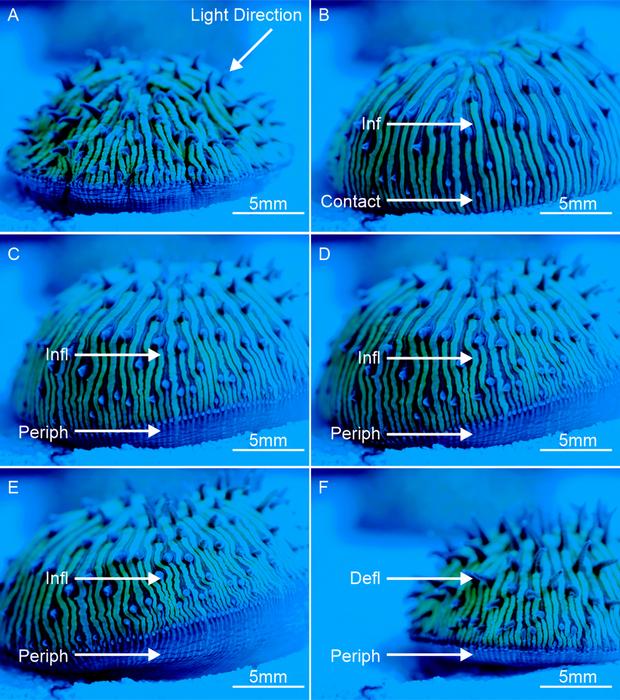
Walking Coral: Unraveling the Mysteries of Phototactic Mobility
In a groundbreaking study, researchers have unveiled the fascinating ability of the free-living coral species, Cycloseris cyclolites, to exhibit complex phototactic mobility in response to light stimuli. This captivating behavior is characterized by the corals’ ability to “walk” towards preferred light wavelengths, such as blue or white light, through a series of rolling, sliding, or pulsating movements. The findings, published in the prestigious journal PLOS One, suggests a remarkable adaptability and awareness in these seemingly simple marine organisms.
The research team, comprising scientists from Australia and Saudi Arabia, meticulously conducted experiments to analyze how C. cyclolites interacts with varying light sources. Their objective was to gain insights into the mechanisms behind the coral’s movements and the ecological advantages that such mobility may confer. By utilizing advanced imaging techniques and controlled laboratory environments, the researchers documented the intricate tissue behavior of the corals as they navigated toward light.
The significance of these findings extends beyond mere observation. Light plays a crucial role in the survival of corals, influencing photosynthesis and, subsequently, growth and health. As the coral samples were exposed to specific light wavelengths, the researchers noted distinct behavioral patterns, indicating an intrinsic response mechanism. This behavior highlights not only the corals’ need for optimal environmental conditions but also their sensory capabilities.
The implications of this study are profound, as they contribute to a broader understanding of coral ecology. By identifying the factors that drive phototactic movements in C. cyclolites, scientists can better appreciate the symbiotic relationships these corals maintain with zooxanthellae—photosynthetic algae that reside within their tissues. The mobility observed may be a strategic adaptation, allowing the corals to position themselves optimally for light exposure, thereby enhancing their nutritional intake and overall vitality.
Moreover, the research sheds light on how this behavior could play a role in the resilience of coral reefs amidst changing environmental conditions. As global warming and ocean acidification pose significant threats to reef ecosystems, understanding the inherent behaviors of corals that promote survival is crucial. Adaptive mobility in response to light may serve as one of the many survival strategies that corals employ to thrive in their habitats.
The visual documentation accompanying the study is particularly striking. High-definition macro DSLR images vividly illustrate the corals’ dynamic movements and the intricate tissue interactions as they engage in phototactic behavior. These images serve to deepen our appreciation of the biological wonders of marine life and the sophisticated responses that have evolved over millennia.
Research of this nature is essential for informing conservation strategies aimed at protecting coral ecosystems worldwide. The findings prompt questions about how other coral species might similarly respond to light and environmental variables, leading to further scientific inquiries. It also emphasizes the importance of preserving natural habitats where these behaviors can be observed, paving the way for future research opportunities.
In light of the dramatic decline of coral reefs globally, studies like this serve not just as academic contributions but also as calls to action. They remind us of the fragility of marine ecosystems and highlight the need for enhanced conservation efforts. Through education and awareness, we can foster a greater appreciation for these incredible organisms and the roles they play in maintaining the health of ocean environments.
The authors of the study, Lewis et al., are recognized for their interdisciplinary approach, combining ecological, biological, and technological perspectives to address the complexities of coral behavior. This collaborative effort underscores the importance of diverse expertise in advancing scientific understanding, particularly in fields as intricate as marine biology.
As this research captures the attention of the scientific community and the public alike, it stands to inspire future explorations into the marvels of marine life. The potential for discovering additional behaviors and adaptations among coral species remains vast, encouraging ongoing investigation and dialogue within the realm of marine science.
In summary, the research exploring the phototactic mobility of Cycloseris cyclolites offers a window into the remarkable capabilities of corals, challenging our perceptions of these organisms as passive entities. Instead, it presents them as dynamic players in their ecosystems, responsive to their surroundings and capable of remarkable feats of movement and adaptation. As we continue to uncover the secrets of marine life, studies like this pave the way for new understanding and appreciation of the natural world around us.
With the publication of this study, the world gains insight not only into the behaviors of corals but also into the broader implications for biodiversity and ecosystem sustainability. The journey of discovery continues, and with it, a renewed commitment to safeguarding our oceans and the life that thrives within them.
Subject of Research: Phototactic mobility in the free-living coral Cycloseris cyclolites
Article Title: Walking coral: Complex phototactic mobility in the free-living coral Cycloseris cyclolites
News Publication Date: 22-Jan-2025
Web References: 10.1371/journal.pone.0315623
References: Lewis et al., 2025, PLOS One, CC-BY 4.0
Image Credits: Lewis et al., 2025, PLOS One, CC-BY 4.0
Keywords: Phototactic mobility, Cycloseris cyclolites, coral behavior, marine biology, coral ecology, conservation, biodiversity, marine ecosystems.
Tags: coral conservationcoral locomotioncoral photoreceptioncoral reef resilienceCycloseris cyclolitesenvironmental adaptationlight wavelength responsemarine ecologyphototactic mobilityPLOS One studypulsing-sliding movementzooxanthellae symbiosis





